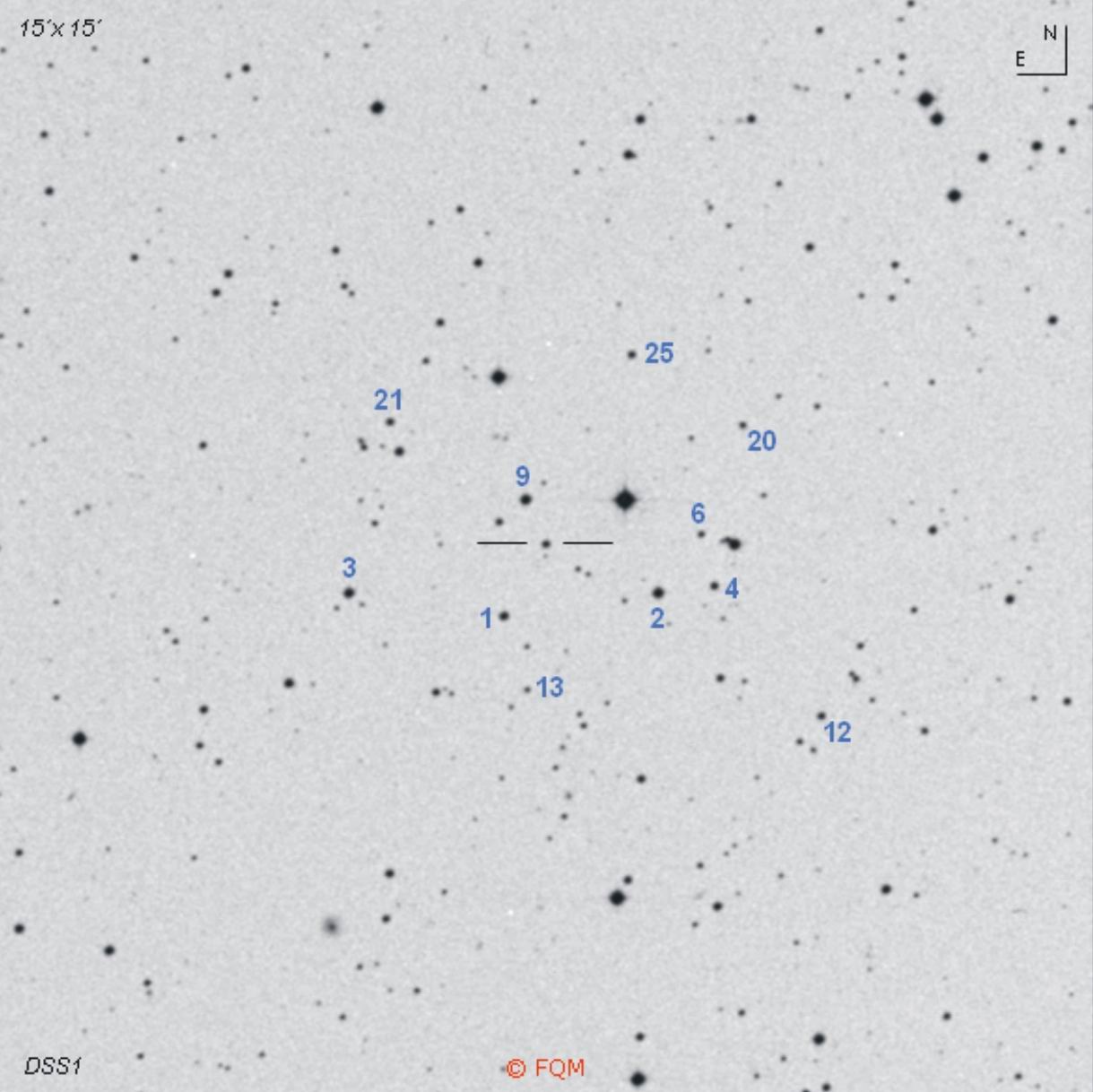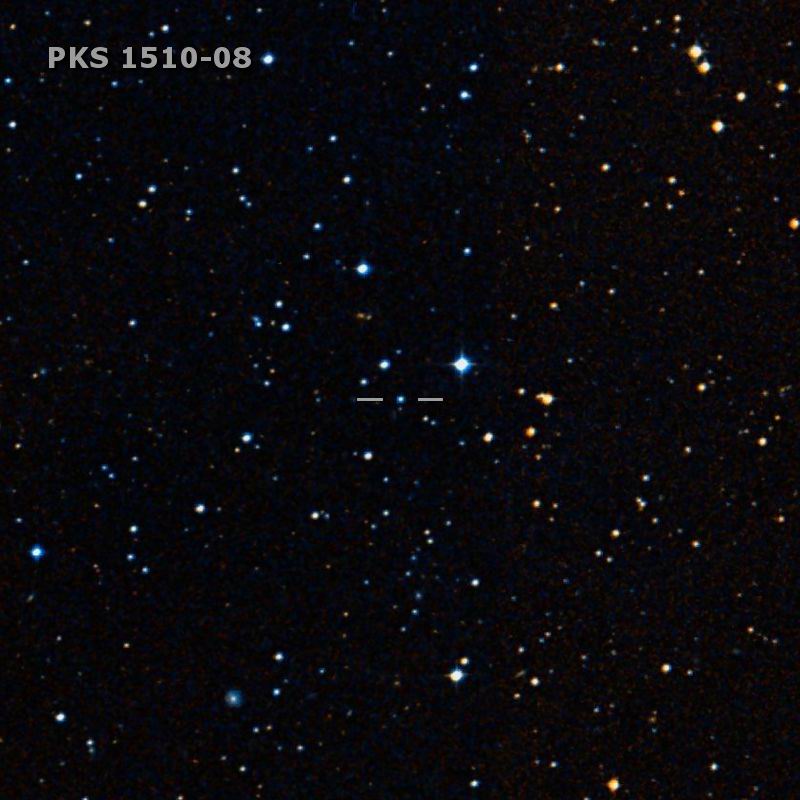
| Frankfurt Quasar Monitoring |
| PKS 1510-08 |
| Cross-Identifications | OR-017, LEDA 2828331, TXS 1510-089, 1510-089 QSO J1512-0906, WMAP J1512-0905, 1E 1510.0-0854 XSS J15128-0858, 2EG J1513-0857, 3EG J1512-0849 2MASS J15125052-0905598, 1AXG J151249-0906 |
| Equat. coordinates |
RA 15 12 50.5 DE -09 06 00 (J2000) |
| Constellation | Libra |
| Type | QSO |
| Redshift (2) | z=0.360 |
| Distance (2) (3) | 1366 Mpc |
| Total mag range (mv) (4) | 11.6 - 18.1 |
| Catalog Magnitude | 16.54v (1) / 18.2g (2) |
| Absolute Magnitude (1) | -25.1 MB |
| Light Travel-Time (2) | 3.821 × 109 yrs |

Comparison stars
| star | B | V | Rc | Ic |
| 2 | 15.123
(0.003) |
14.400
(0.004) |
13.960
(0.003) |
13.516
(0.001) |
| 9 | 15.302
(0.005) |
14.658
(0.003) |
14.254
(0.004) |
13.891
(0.010) |
| 3 | 15.516
(0.008) |
14.803
(0.003) |
14.381
(0.002) |
13.999
(0.004) |
| 1 | 16.201
(0.007) |
15.237
(0.004) |
14.630
(0.005) |
14.100
(0.007) |
| 4 | 16.656
(0.052) |
15.483
(0.009) |
14.651
(0.001) |
13.889
(0.004) |
| 12 | 16.812
(0.117) |
16.060
(0.009) |
15.527
(0.003) |
15.031
(0.020) |
| 21 | 17.042
(0.014) |
16.217
(0.010) |
15.709
(0.009) |
15.258
(0.008) |
| 25 | 16.959
(0.042) |
16.437
(0.009) |
16.101
(0.012) |
15.677
(0.012) |
| 20 | 17.540
(0.078) |
16.743
(0.113) |
16.414
(0.022) |
15.999
(0.025) |
| 6 | 17.600
(0.018) |
16.911
(0.009) |
16.493
(0.007) |
16.014
(0.013) |
| 13 | 18.529
(0.050) |
17.281
(0.018) |
16.587
(0.012) |
15.920
(0.033) |


| PKS
1510-08 is a high polarization quasar (HPQ) in Libra, only about 1° WSW of
2.5-mag Beta Librae. It is one of the most violently variable sources
with remarkable flux changes through all wavebands. This object was
discovered as a radio source in 1964/1965 during the Parkes Radio Survey (PKS). In
1966, the new radio source was matched with a v=16.52 stellar object.
In the same year, follow-up spectroscopy revealed a Seyfert 1-spectrum.
In addition, a redshift of z=0.361 was determined, which corresponds to
a light travel time of 3.8 Gyrs. The actual redshift value is z=0.360. Soon after, the new quasar was found to be variable at both radio and optical wavelengths. Radio interferometry revealed a core-jet structure with a radio jet extending up to about 10 mas. Besides the optical and radio, quasar PKS 1510-08 has been detected also as a source of emissions in UV, X-ray and even gamma wavelenghts. The optical and radio flux properties of this QSO show similarities with BL Lacertae-like objects. That is why this object was also classified as a blazar by some authors. _________ PKS 1510-08 is a violently variable quasar with a total range of about 6 magnitudes. On average this object rests around 16 mag to 17 mag in the optical, interrupted by short peak-like outbursts (see light curve above). This quasar displays large and rapid flux variations in all observed wave bands from radio to gamma-rays. A look at the light curve above makes clear that quasar PKS 1510-08 is a preferred target for CCD observers. Visual observers may only have a chance to glimpse this stellar object during the rare outbursts. Even with large instruments the quasar remains stellar. CCD observers as well as visual observers shall use the comparison stars given above. Other photometric sequences were published by Villata et al. (1997), Raiteri et al. (1998), Smith & Balonek (1998), and Doroshenko et al. (2005), which underlines the high astrophysical interest in this unusual quasar. |
| Bolton, J.G, Kinman, T.D. 1966, ApJ, 145, 951B; Radio and optical data on twelve quasi-stellar objects. Burbidge, E.M., Kinman, T.D. 1966, ApJ, 145, 654B; Redshifts of fourteen quasi-stellar radio sources. Doroshenko, V.T., Sergeev, S.G., et al. 2005, Ap, 48, 304D; BVRI CCD-Photometry of Comparison Stars in the Neighborhoods of Galaxies with Active Nuclei. II. Ekers, J.A. 1969, AuJPA, 7, 3E; The Parkes Catalogue of Radio Sources. Declination Zone +20° to -90°. Ghosh, K.K., Soundararajaperumal, S. 1995, ApJS, 100, 37; Multifrequency Spectra of EXOSAT Blazars. González-Pérez, J.N., Kidger, M.R., et al. 2001, AJ, 122, 2055; Optical and Near-Infrared Calibration of AGN field stars: An All-Sky Network of faint stars calibrated on the Landolt System. Hewitt, A., Burbridge, G., 1993, ApJS, 87, 451; A revised and updated catalog of quasi-stellar objects. Liller, M.H., Liller, W. 1975, ApJ, 199, 133L; Photometric histories of QSOs: Two QSOs with large light amplitude. Raiteri, C.M., Villata, M., et al. 1998, A&AS, 130, 495; BVR photometry of comparison stars in selected blazar fields. II. Sambruna, R.M., et al. 2004, ApJ, 608, 698; A Survey of extended Radio Jets with Chandra and the Hubble Space Telescope. Smith, P.S., Balonek, T.J. 1998, PASP, 110, 1164; Photometric Calibration of Stars in the Fields of Selected BL Lacertae Objects and Quasars. Véron-Cetty, M.-P., Véron, P. 2001, A&A 374, 92; A Catalogue of Quasars and Active Nuclei: 10th edition. Véron-Cetty, M.-P., Véron, P. 2003, A&A 412, 399; A Catalogue of Quasars and Active Nuclei: 11th edition. Véron-Cetty, M.-P., Véron, P. 2006, A&A 455, 776; A Catalogue of Quasars and Active Nuclei: 12th edition. Véron-Cetty, M.-P., Véron, P. 2010, A&A 518, 10; A Catalogue of Quasars and Active Nuclei: 13th edition. Villata, M., Raiteri, C.M., et al. 1997, A&AS, 121, 119; Optical photometric monitoring of gamma-ray loud blazars. I. |
| Links: Landessternwarte Heidelberg (1) Landessternwarte Heidelberg (2) Hamburg Quasar Monitoring Chara/PEGA |